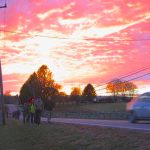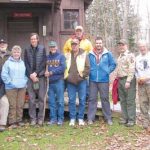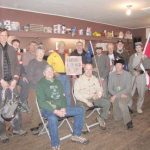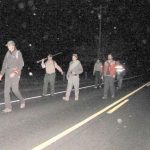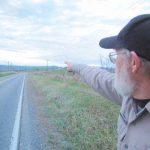It was ten at night and snow was starting to fall on the south face of Droop Mountain. It could have been closer to midnight but after having walked for 20 miles or so already, it didn’t really matter. The passage of time becomes just so much trivia to a person who accepts that there is no stopping until their Long Distance Destination is reached.
So time had become an amorphous haze for me but what did seem particularly relevant were my feet, which ached with every step I took up that mountainside.
Of Course, I was not alone on this late night trek. Fifteen of us started from Lewisburg earlier that day as part of a Civil War Memorial Hike commemorating the 150th anniversary of the Battle at Droop Mountain.
Droop Mountain Battlefield State Park Supervisor Mike Smith came up with the idea of staging four Memorial Hikes to commemorate the Sesquicentennial anniversary of this important Civil War Battle in what is today West Virginia but what was then disputed land.
It was at the Battle of Droop Mountain where the Confederacy lost any hope of ever regaining the lands of Western Virginia from the Federals.
The road the Rebels travelled in 1863 under Brigadier General John Echols follows the same path as today’s US Route 219 and we, in turn, would follow the highway 28 miles from Downtown Lewisburg to Droop Mountain Battlefield State Park.
And so it was that on the afternoon of Nov. 5, we few, from various walks of life began the last and longest of these Memorial Hikes to Droop Mountain Battlefield.
The plan was to walk along a major highway through the mountains at night, which might seem a little dangerous but since this memorial hike honors these brave men we figured a reasonable amount of dangerousness seemed appropriate.
One need only consider the rebel soldiers who walked this same path a century and a half ago. They could expect to fight immediately upon arrival at Droop. Some would experience hand-to-hand combat. All would be routed and many killed. Our small band faced possible cardiac arrest but no chance of mortal combat come daybreak.
Even so, traffic remained disconcertingly heavy for the first five miles of the trek. Trucks rushed past at close quarters and road kill was plentiful.
A few miles distance from Lewisburg afforded a view of the sunset, less traffic and more time to get to know my companions in reenactment.
Caleb and Issach Skaggs, who were the only hikers dressed in authentic Confederate uniforms, marched in Memory of their great-great-great-great-grandfather, Henry H. Skaggs who lost a leg at the Battle of Droop Mountain but survived to reenlist for the Confederate cause.
Father and son hikers Danny and Chad Morrison had three direct ancestors who fought for the Union at Droop and lived to tell the tale.
The wife of Christofer Quasebarth, a lawyer from Winchester Virginia is a direct descendent of one the warriors of Droop Mountain and that was a good enough reason for him to go.
Sixty-two year old J. Thompson of Danville, WV, simply read about the event in a Charleston newspaper and decided to do it.
Attorney Roger Forman from nearby Buckeye, WV, figured that the Memorial Hike to Droop would make for a memorable way for him to celebrate his 64th birthday.
The only female who took the hike, Gayle Hyer of the Pocahontas County Convention and Visitors Bureau took on the trek with her typically buoyant attitude.
John Dudley, a 44 year old Air Force vet from Ohio wore his Cub Scout Den Leader’s uniform on the hike and expressed his desire to promote patriotism.
Memorial hikers all shared the desire to honor those who marched into combat but members of this group also possessed a common strain of fierce individualism.
John Dudley slaughters his own hogs so as not to expose his children to meats laden with chemicals.
Bill Jackson retired from the gas company and started his own small farm and claims to have never touched a drop of alcohol in his life.
Nineteen year-old Caleb Skaggs and his 17-year-old brother Isaac were both homeschooled and fiercely devoted to organic food and faith in God.
Park Superintendent Mike Smith is, himself, a unique and interesting person simply by light of his long-term dedication to this lonely outpost of Civil War History. Mike Smith moved to the top of Droop Mountain 29 years ago and has never looked back. Smith doesn’t drink either and never intends to.
Night fell both for us and for the Confederate army well before reaching the little town of Renick which marks the beginning of several climbs up towards the site of the battle.
For my own nod to the Boys in Gray that night I decided to wear my cheapest work shoes because they looked like something a Reb soldier might wear and because I figured to be as uncomfortable as any of those fellows were. I also decided to wear all wool and cotton clothing along with a fairly heavy pack even though it became obvious early on that I would not need it.
Assistant Superintendent Kelly Smith from nearby Watoga State Park and Droop Mountain assistant Brian Puffenbarger materialized every 3 or 4 miles with a van full of snacks and even a porta-potty hooked to a trailer. When night fell they made sure everyone had reflective gear and or some type of lighted devise on their person.
I reached the high point of the trail at Bear Town State Park before any of my fellow travellers and was in good spirits but the last 5 miles proved more difficult. As my blisters awakened and my backpack grew heavier, I began limping slightly on our approach to the battlefield.
True to form, Superintendent Mike Smith came to the rescue by telling me stories about the historic march and the subsequent battle. Smith’s extensive knowledge and easy-going style diverted my attention from my blistered feet and aching back long enough for me to finish the hike.
We arrived at Droop Mountain State Park at about 1:15 in the morning without fanfare or audacious celebration, which seemed appropriate. After all, we weren’t finishing a 5K, we were commemorating a march which led to extreme violence sometimes pitting brother against brother and father against son. This march led to death and eventual defeat for those who tread our same steps.
Still, we weren’t too broken up. We posed for a picture and felt well about what we’d done knowing all the while that our little jaunt couldn’t really compare with that dread filled hike to the battle 150 years ago.
The Confederates held their ground against the Union onslaught until eventually being routed by a brilliant if not entirely unforeseen flanking maneuver led by Colonel Augustus Moor
Using the same road from whence they came, the Confederate army made a headlong retreat back to Lewisburg with the Union Army’s Commanding General William W. Averell in hot pursuit.
On Nov. 6, the day the Battle at Droop Mountain occurred in 1863, Park Supervisor Mike Smith unveiled a 12 foot tall sandstone monument with the names of all who fell at the battle, whether Yankee or Rebel, inscribed at its base. Civil War reenactors dressed in blue and gray stood at attention as the names of each fallen soldier was read aloud, likely for the first time in history.
Terry Lowry, the author of The Last Sleep, a book about the Battle of Droop Mountain was one of several notable personalities who read the names of the dead. For 13 years Superintendent Mike Smith helped Lowry gather information for The Last Sleep, which is likely the most comprehensive history ever written in relation to this battle.
The 2013 government shutdown occurred just a couple of weeks before this experience but nobody mentioned it. I did happen to think, though, how if all government were as well run as the West Virginia Park Service we’d all be better off. Mike Smith is a prime example of a typical West Virginia Park Service employee in that he is professional without being overbearing and completely knowledgeable in relation to his given post. Mike and his wife Christine proved to be gracious hosts for all who stayed through the night waiting for the next day’s unveiling.
So you might ask why hike through the night, what was accomplished? To which I might reply “Not sure, but if I marched almost 30 miles to take a bullet defending hearth and home it would be nice to know that somebody took note of that 150 years later.” So I took note of their unhappy march and lived it just for a little bit and I’ve got the blisters on my feet to prove it.



